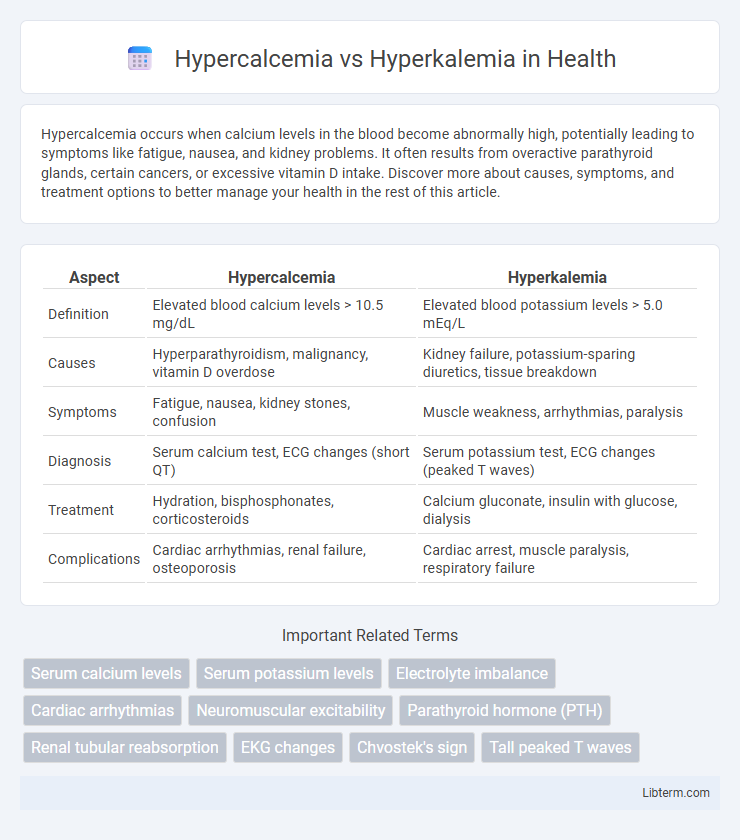Hypercalcemia occurs when calcium levels in the blood become abnormally high, potentially leading to symptoms like fatigue, nausea, and kidney problems. It often results from overactive parathyroid glands, certain cancers, or excessive vitamin D intake. Discover more about causes, symptoms, and treatment options to better manage your health in the rest of this article.
Table of Comparison
| Aspect | Hypercalcemia | Hyperkalemia |
|---|---|---|
| Definition | Elevated blood calcium levels > 10.5 mg/dL | Elevated blood potassium levels > 5.0 mEq/L |
| Causes | Hyperparathyroidism, malignancy, vitamin D overdose | Kidney failure, potassium-sparing diuretics, tissue breakdown |
| Symptoms | Fatigue, nausea, kidney stones, confusion | Muscle weakness, arrhythmias, paralysis |
| Diagnosis | Serum calcium test, ECG changes (short QT) | Serum potassium test, ECG changes (peaked T waves) |
| Treatment | Hydration, bisphosphonates, corticosteroids | Calcium gluconate, insulin with glucose, dialysis |
| Complications | Cardiac arrhythmias, renal failure, osteoporosis | Cardiac arrest, muscle paralysis, respiratory failure |
Understanding Hypercalcemia and Hyperkalemia
Hypercalcemia is characterized by elevated calcium levels in the blood, often caused by hyperparathyroidism or malignancies, leading to symptoms such as muscle weakness, confusion, and cardiac arrhythmias. Hyperkalemia involves increased potassium levels, frequently resulting from kidney dysfunction, medications, or cell breakdown, and can cause dangerous cardiac conduction abnormalities and muscle paralysis. Accurate diagnosis through serum electrolyte measurement is critical for managing both electrolyte imbalances and preventing life-threatening complications.
Key Differences Between Hypercalcemia and Hyperkalemia
Hypercalcemia is characterized by elevated calcium levels in the blood, often caused by hyperparathyroidism or malignancies, while hyperkalemia involves high potassium levels, typically due to kidney dysfunction or medication effects. Symptoms of hypercalcemia include muscle weakness, fatigue, and kidney stones, contrasting with hyperkalemia's muscle cramps, cardiac arrhythmias, and potential cardiac arrest. Diagnostic tests measure serum calcium and potassium concentrations, guiding condition-specific treatment such as calcium-lowering agents for hypercalcemia and potassium-binding resins or dialysis for hyperkalemia.
Causes of Hypercalcemia
Hypercalcemia is primarily caused by primary hyperparathyroidism, malignancies such as multiple myeloma or metastatic cancers, and excessive vitamin D intake. Other factors include prolonged immobilization, certain medications like thiazide diuretics, and granulomatous diseases such as sarcoidosis. Hyperkalemia, in contrast, is mainly due to kidney failure, adrenal insufficiency, or the use of potassium-sparing diuretics.
Causes of Hyperkalemia
Hyperkalemia primarily results from impaired renal excretion due to acute or chronic kidney disease, leading to potassium retention in the bloodstream. Other common causes include excessive potassium intake, cellular breakdown from conditions like rhabdomyolysis or hemolysis, and medications such as potassium-sparing diuretics, ACE inhibitors, or NSAIDs that disrupt potassium balance. Endocrine disorders like hypoaldosteronism and metabolic acidosis also contribute by reducing potassium elimination, distinguishing hyperkalemia's pathophysiology from hypercalcemia, which involves calcium metabolism and parathyroid hormone abnormalities.
Symptoms of Hypercalcemia
Hypercalcemia symptoms predominantly include nausea, vomiting, excessive thirst, frequent urination, muscle weakness, and confusion due to elevated calcium levels in the blood. Unlike hyperkalemia, which primarily affects cardiac function causing arrhythmias and muscle paralysis, hypercalcemia often leads to neurological symptoms and kidney issues. Early recognition of hypercalcemia symptoms is crucial for preventing complications like kidney stones and cardiac arrhythmias.
Symptoms of Hyperkalemia
Hyperkalemia manifests through muscle weakness, fatigue, and cardiac arrhythmias due to elevated potassium levels disrupting normal muscle and nerve function. Symptoms may also include nausea, irregular pulse, and in severe cases, paralysis or sudden cardiac arrest. Unlike hypercalcemia, which primarily causes bone pain and kidney stones, hyperkalemia requires immediate medical attention to prevent life-threatening complications.
Diagnostic Approaches for Hypercalcemia vs Hyperkalemia
Diagnostic approaches for hypercalcemia typically involve serum calcium measurement, corrected for albumin levels, alongside parathyroid hormone (PTH) assays to distinguish primary hyperparathyroidism from malignancy-associated hypercalcemia. In contrast, hyperkalemia diagnosis focuses on serum potassium levels supported by electrocardiogram (ECG) changes such as peaked T waves, widened QRS complexes, and arrhythmias to assess cardiac risk. Both conditions require evaluation of underlying causes through biochemical panels, renal function tests, and, where indicated, imaging studies to identify etiologies like hyperparathyroidism or renal impairment.
Treatment Strategies for Hypercalcemia
Treatment strategies for hypercalcemia prioritize lowering serum calcium levels through intravenous hydration with isotonic saline to promote renal calcium excretion. Bisphosphonates like pamidronate or zoledronic acid inhibit osteoclast-mediated bone resorption, proving effective, especially in malignancy-related hypercalcemia. In severe or refractory cases, calcitonin and corticosteroids may be used to reduce calcium levels rapidly and address underlying causes.
Treatment Options for Hyperkalemia
Treatment options for hyperkalemia include intravenous calcium gluconate to stabilize cardiac membranes, insulin with glucose to shift potassium into cells, and sodium bicarbonate for acidosis correction. Loop diuretics such as furosemide promote renal potassium excretion, while potassium binders like sodium polystyrene sulfonate or patiromer enhance gastrointestinal removal. In severe cases, hemodialysis is employed to rapidly reduce serum potassium levels and prevent cardiac arrhythmias.
Prevention and Long-Term Management of Electrolyte Imbalances
Prevention of hypercalcemia involves adequate hydration, limiting calcium and vitamin D intake, and monitoring medications such as thiazide diuretics and lithium. Hyperkalemia prevention focuses on dietary potassium restriction, especially in patients with chronic kidney disease, and careful management of medications like ACE inhibitors, ARBs, and potassium-sparing diuretics. Long-term management includes regular electrolyte monitoring, treatment of underlying conditions, and patient education on recognizing symptoms to prevent complications such as cardiac arrhythmias and neuromuscular dysfunction.
Hypercalcemia Infographic

 libterm.com
libterm.com